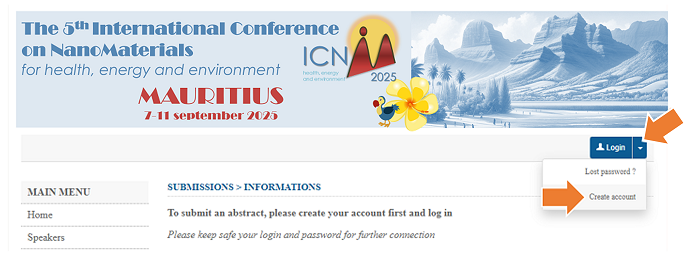
|
|
|
Submissions > InformationsTo submit an abstract, please create your account first and log in
To dowload the abstract template, click on the link below:
Your submission will be accepted for reviewing:
Otherwise your submission will be rejected.
Topic(s) to select to submit your abstract A: NANOTECHNOLOGY FOR HEALTH including: synthetic/biopolymer hybrids, nanomedicine, drug delivery, bionanocomposites, sensors and biosensors, therapy and diagnostics (“theranostics”), imaging, targeting, in vivo and in vitro applications, nano-bio interface, biomedical materials, synthetic implants. B: NANOTECHNOLOGY FOR ENERGY including: materials for renewable energy, materials for energy conversion and storage, emerging materials for energy technologies, photovoltaic materials and devices; electrode and electrolyte materials for batteries, fuel cells and supercapacitors; catalysts, biocatalysts and electrocatalysts; novel materials for energy based on sol-gel derived hybrid materials, mesoporous and hierarchical architectures, nanocomposites, bioinspired and biomimetic materials C: NANOTECHNOLOGY FOR THE ENVIRONMENT including: green materials and green manufacturing, living materials, synthetic materials membranes, sorbents and solid phase extraction, nuclear waste, light harvesting, sensors, ’nano safety’, ’fate and transport’ (of nano particles), ‘safer by design’, aquatic, terrestrial, atmospheric applications, approaches for clean energy, life-cycle analysis, agricultural applications. D: SYNTHESIS AND DESIGN OF NANOSCALE FUNCTIONAL MATERIALS including: self-assembly, mesoporous materials, zeolites, MOFs, micro- and macrocellular materials, bioinspired, biomimetic materials, biomineralisation, biotemplates, hierarchically structured materials, functional hybrid nanoparticles and nanotubes, functional nanostructures, self-organisation of nano-objects (size and shape-controlled nanoparticles), nanocomposites, colloidal materials; nano machines, transducers, assemblies; lithography, 3D-printing materials and their applications; nanomaterials with targeted electronic, magnetic and optical properties. E: CHARACTERIZATION AND COMPUTATIONAL METHODS including: characterization techniques such as X-ray diffraction, TEM, UV/Vis, Raman and IR spectroscopies, gas adsorption/desorption, dynamic light scattering, solid-state NMR; tools for in-operando measurements; synthesis, shape control, structure and growth mechanisms, computational chemistry, modeling and simulation, surface modification & characterization; coatings technology.
|


